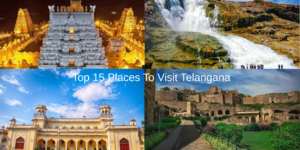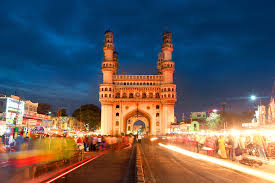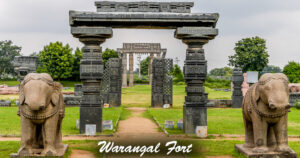Medak Cathedral, located in the town of Medak in Telangana, India, is one of the largest and most beautiful churches in the country. Built in the early 20th century by the British Wesleyan Methodist Mission, it was consecrated in 1924 and is now a part of the Church of South India (CSI). The cathedral is renowned for its impressive Gothic-style architecture, which features massive stained-glass windows that depict scenes from the life of Jesus Christ, including the Nativity, Crucifixion, and Resurrection. These vibrant glass panels, imported from Britain, are a key highlight of the church and attract thousands of visitors every year. Constructed using white granite, the cathedral stretches over 100 feet in height and can accommodate nearly 5,000 people at a time, making it one of the largest churches in Asia.
What makes this church even more special is the story behind its construction: during a severe famine in the early 1900s, the local bishop employed thousands of people to build the church, giving them both livelihood and purpose. As a result, the cathedral stands not only as a place of worship but also as a symbol of hope and compassion. Surrounded by serene landscapes and rich in historical significance, Medak Cathedral remains a major spiritual and architectural landmark in South India.
8.Statue Of Eqality

The Statue of Equality, located near Hyderabad in Telangana, India, is a monumental tribute to the 11th-century saint and philosopher Sri Ramanujacharya, who is known for promoting the ideals of equality and social justice. Inaugurated in February 2022, this grand statue was built to commemorate the 1,000th birth anniversary of the revered saint. Standing at a height of 216 feet, it is one of the tallest metallic sitting statues in the world. The statue is crafted from panchaloha, a traditional five-metal alloy consisting of gold, silver, copper, brass, and zinc, symbolizing spiritual and cultural richness. It is seated on a 54-foot high base building called the Bhadra Vedi, which houses a museum, a digital library, Vedic knowledge centers, and galleries that highlight the life, teachings, and contributions of Sri Ramanujacharya.
The project was conceptualized and developed under the guidance of Sri Chinna Jeeyar Swami, a prominent spiritual leader. The site also features 108 intricately carved Divya Desams—temples that are significant in the Vaishnavite tradition. The Statue of Equality is not just a religious monument but also a cultural landmark that inspires values of unity, compassion, and inclusiveness. It attracts devotees, tourists, and scholars from across the globe who come to learn about Ramanujacharya’s vision of a just and equal society, making it a beacon of India’s spiritual and philosophica
9.Kuntala Waterfalls
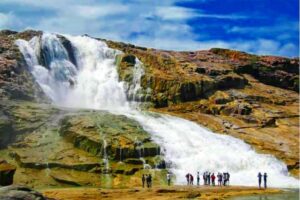
Kuntala Waterfall, located in the Adilabad district of Telangana, is the highest waterfall in the state and one of the most scenic natural attractions in South India. Nestled amidst the dense forests of the Sahyadri mountain range, the waterfall cascades from a height of approximately 147 feet (45 meters) and is formed by the Kadam River, a tributary of the Godavari. Surrounded by lush greenery and rocky terrain, Kuntala offers a breathtaking view, especially during the monsoon season when the water flow is at its peak and the surrounding vegetation comes alive with vibrant colors. According to local legend, the waterfall gets its name from Shakuntala, the beloved wife of King Dushyanta from the epic Mahabharata, who is believed to have bathed in the waters of this fall.
The location is not only a visual treat but also a peaceful retreat for nature lovers, adventure enthusiasts, and photographers. Visitors often trek through short forest trails to reach the waterfall, adding a touch of excitement to the experience. The area around the falls is relatively undeveloped, which helps preserve its natural charm, though basic amenities like viewing platforms and resting spots are available. Kuntala Waterfall is a perfect destination for weekend getaways, picnics, and eco-tourism, drawing thousands of tourists every year who come to experience the serenity and power of nature in its purest form.
10.Bogatha Waterfalls
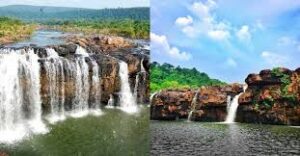
Bogatha Waterfalls, often referred to as the “Niagara of Telangana,” is a stunning natural waterfall located in the Mulugu district of Telangana, near the borders of Chhattisgarh. It is one of the most picturesque and lesser-known waterfalls in the state, making it a hidden gem for nature lovers and adventure seekers. The waterfall is formed by the Cheekupally Vagu, a tributary of the Godavari River, and drops from a height of around 30 meters, creating a wide curtain of water that flows gracefully over the rocks. Surrounded by dense forests and hills, Bogatha offers a peaceful and untouched natural setting, ideal for eco-tourism. Unlike commercial tourist spots, Bogatha retains its raw and tranquil charm, making it especially popular among trekkers, cyclists, and photographers who enjoy exploring offbeat locations. To reach the falls, visitors often need to hike or cycle through scenic trails, crossing a bridge over the Godavari River, which adds an element of adventure to the journey. The area is particularly beautiful during and after the monsoon season when the water flow is at its peak and the surrounding greenery is lush and vibrant. Though it lacks large-scale tourist infrastructure, basic facilities and a viewing deck have been developed by the local administration to support growing interest. Bogatha Waterfalls is more than just a scenic spot—it is a place where one can reconnect with nature, enjoy the sound of cascading waters, and escape the noise of everyday life.
11.Nagarjuna Sagar Dam

Nagarjuna Sagar Dam is one of the largest and most significant multipurpose dams in India, located on the Krishna River in the Nalgonda district of Telangana, near the border with Andhra Pradesh. Constructed between 1955 and 1967, the dam was named after the ancient Buddhist scholar and philosopher Acharya Nagarjuna, who once lived in the region. It stands as a remarkable example of post-independence engineering and development, symbolizing India’s efforts toward harnessing natural resources for national progress. The dam stretches across a length of 1.6 kilometers and rises to a height of about 124 meters, creating one of the largest man-made reservoirs in the world, known as Nagarjuna Sagar Reservoir, which has a storage capacity of over 11,000 million cubic meters.Its primary functions include irrigation, hydroelectric power generation, and water supply for domestic and industrial use. The dam provides water to vast areas of agricultural land across Telangana and Andhra Pradesh, significantly contributing to the region’s agricultural productivity. In addition to its utilitarian value, the area around Nagarjuna Sagar is rich in historical and cultural significance. The nearby Nagarjunakonda island, now a popular tourist attraction, houses ancient Buddhist ruins that were relocated during the dam’s construction. Surrounded by hills and offering panoramic views of the water and surrounding greenery, the site is also a scenic destination for travelers. With its blend of engineering marvel, historical relevance, and natural beauty, Nagarjuna Sagar Dam stands as a landmark of both technological achievement and cultural heritage in India.
12.Chowmahal Palace
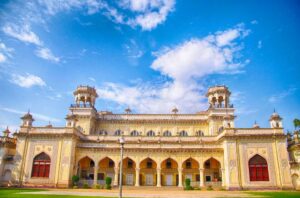
Chowmahal Palace, located in the heart of Hyderabad, Telangana, is a magnificent architectural masterpiece that once served as the official residence of the Nizams of Hyderabad, who ruled the princely state from the 18th to the mid-20th century. The name “Chowmahal” translates to “Four Palaces” in Persian and Urdu, reflecting the palace’s structure, which comprises four grand palaces within its complex. Construction began in the mid-18th century under Nizam Salabat Jung and was completed in the 19th century during the reign of Afzal ad-Dawlah, Asaf Jah V. The palace complex is a fine example of Indo-Saracenic architecture, blending elements of Mughal, Persian, and European styles. Its grand courtyards, exquisite chandeliers, intricate stucco work, and expansive halls reflect the opulence and sophistication of the Nizam era.
The Khilwat Mubarak, or the grand Durbar Hall, is the centerpiece of the palace, where ceremonial functions and official gatherings were once held under dazzling Belgian crystal chandeliers. The palace also includes vintage cars, royal artifacts, rare manuscripts, clothing, and portraits of the Nizam dynasty, offering a glimpse into Hyderabad’s royal past. Restored and opened to the public, Chowmahal Palace has become a prominent heritage site and tourist attraction, drawing visitors from around the world who come to admire its regal architecture and historical significance. It stands not only as a symbol of the Nizams’ grandeur but also as a preserved piece of Hyderabad’s rich cultural and political history.
13.Yadagirigutta Temple
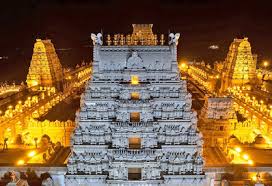
Yadagirigutta Temple, also known as Sri Lakshmi Narasimha Swamy Temple, is a prominent Hindu pilgrimage site located in the town of Yadagirigutta (recently renamed Yadadri) in the Yadadri Bhuvanagiri district of Telangana, India. Perched on a scenic hilltop about 60 kilometers from Hyderabad, the temple is dedicated to Lord Narasimha, an incarnation of Lord Vishnu known for his fierce yet protective nature. According to legend, the temple was established after a great sage named Yadava, a devout follower of Lord Narasimha and son of the famous sage Rishyasringa, performed intense penance on this hill. Pleased by his devotion, the Lord appeared in five different forms — Jwala Narasimha, Yogananda, Ugra Narasimha, Gandaberunda, and Lakshmi Narasimha — all of which are believed to be enshrined in the temple.
This makes Yadagirigutta unique, as it is one of the few temples where the deity is worshipped in multiple forms in a single shrine. The temple is undergoing a massive transformation, with the government of Telangana overseeing the development of a magnificent, gold-covered temple complex that blends traditional Dravidian architecture with modern amenities to accommodate thousands of devotees. The surrounding region is also being developed as a spiritual and cultural hub. Devotees visit the temple not only to seek blessings for protection and prosperity but also to experience its divine energy and peaceful atmosphere. With its growing religious importance and enhanced infrastructure, Yadagirigutta Temple is emerging as one of South India’s most revered and majestic spiritual destinations.
14.Pakhal Lake & Wildlife Sanctuary

Pakhal Lake and Wildlife Sanctuary, located in the Warangal district of Telangana, is a picturesque and ecologically rich destination that combines natural beauty with diverse wildlife. The lake was artificially constructed in the 13th century by Kakatiya ruler Ganapati Deva to harvest water from the nearby hills for irrigation. Surrounded by rolling hills and dense forests, Pakhal Lake spans an area of over 30 square kilometers, and its serene waters provide a perfect backdrop for nature lovers and photographers. Adjacent to the lake lies the Pakhal Wildlife Sanctuary, which covers around 860 square kilometers and is home to a wide variety of flora and fauna.
The sanctuary offers a safe haven for species such as leopards, sloth bears, wild boars, nilgai, spotted deer, langurs, and numerous birds and reptiles. It is especially attractive to birdwatchers due to the presence of both resident and migratory birds. The tranquil environment, combined with the rich biodiversity, makes this sanctuary a preferred spot for eco-tourism, trekking, and nature study. The lake not only supports wildlife but also plays a crucial role in irrigation for the surrounding agricultural lands. The entire region reflects a harmonious balance between man-made ingenuity and natural ecosystems. With its scenic charm, historical roots, and ecological importance, Pakhal Lake and Wildlife Sanctuary stand as a unique destination that draws tourists, researchers, and spiritual seekers alike, offering a peaceful escape into the heart of Telangana’s natural heritage
15.Ramoji Film City

Ramoji Film City, located on the outskirts of Hyderabad, Telangana, is one of the largest and most renowned integrated film studio complexes in the world. Spanning over 2,000 acres, it was established in 1991 by Ramoji Rao, a media tycoon and founder of the Ramoji Group. Recognized by the Guinness World Records as the world’s largest film studio complex, Ramoji Film City is a hub of cinematic creativity, offering everything from pre-production to post-production facilities. The complex features multiple shooting locations, including replicas of urban streets, villages, palaces, gardens, airports, and even railway stations, making it a one-stop destination for filmmakers from across India and abroad. In addition to being a center for film and television production, Ramoji Film City is also a major tourist attraction, drawing millions of visitors every year.
Tourists can enjoy guided studio tours, live film sets, theme parks, adventure zones, and interactive entertainment shows, providing a unique blend of cinema and leisure. The infrastructure includes film studios, sound stages, editing suites, and workshops, along with hotels, restaurants, and shopping areas to accommodate and entertain guests. The Film City also supports educational tours and workshops for aspiring filmmakers and students, making it a cultural and educational landmark. With its state-of-the-art facilities, scenic backdrops, and vibrant atmosphere, Ramoji Film City stands as a symbol of India’s thriving film industry and a must-visit destination for cinema lovers and tourists alike.
